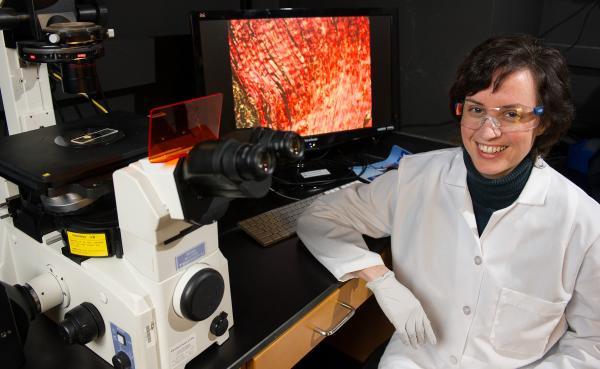Johnna Temenoff was recently named principal investigator (PI), for the Georgia Tech Training Program for Rationally Designed, Integrative Biomaterials (GTBioMAT), and her predecessor, Ravi Bellamkonda, offers a very good reason why.
“Johnna literally wrote the book on the subject,” says Bellamkonda, referring to Biomaterials: The Intersection of Biology and Materials Science, the award-winning undergraduate textbook Temenoff that co-authored (with her mentor at Rice University, A.G. Mikos). Published in 2008, the book has been adopted by more than 40 universities in the U.S. and has been published in three international editions. In 2010, it won the Meriam-Wiley Award for Best New Engineering Textbook by the American Society for Engineering Education.
But Temenoff, an associate professor in the Wallace H. Coulter Department of Biomedical Engineering (BME) and faculty member of the Parker H. Petit Institute for Bioengineering and Bioscience, not only has written the story – she is immersed in it, playing a leading role in the growing body of biomaterials research and study, while ardently supporting the work of Georgia Tech’s biotech graduate students.
“Johnna has been an integral part of the Graduate Leadership Program, and has a strong commitment to graduate education. She is also emerging in the field nationally. "I look forward to our training program attaining greater heights under her leadership,” says Bellamkonda, who chairs the Coulter Department (a collaborative between Tech and Emory).
GTBioMAT, sponsored through a grant from the NIH’s National Institute of Biomedical Imaging and Bioengineering, offers advanced training for pre-doctoral students in the rational design, synthesis, and application of the next generation of integrative biomaterials.
Students receive comprehensive and integrated training, which includes fundamental and interdisciplinary courses (such as the training program’s capstone Rational Design of Biomaterials course and lab), two laboratory rotations (one is a ‘materials synthesis’ and the other is an ‘application/clinical’ experience), and informal interactions with clinicians to gain more insight into the clinical setting.
And GTBioMAT, which also helps trainees develop in other areas (such as leadership, values, and personal development through participation in the aforementioned Graduate Leadership Program), is growing – the NIH added an additional two student slots per year, which Temenoff says, “makes this an exciting time to become the PI. As a co-director for the past three years, I now more fully understand how this grant contributes to building the biomaterials community at Georgia Tech and Emory. Through this new position, I look forward to creating even more opportunities for faculty and students to interact within our already vibrant research environment.”
Media Contact
Jerry Grillo
Communications Officer II
Parker H. Petit Institute for
Bioengineering & Bioscience
Keywords
Latest BME News
Jo honored for his impact on science and mentorship
The department rises to the top in biomedical engineering programs for undergraduate education.
Commercialization program in Coulter BME announces project teams who will receive support to get their research to market.
Courses in the Wallace H. Coulter Department of Biomedical Engineering are being reformatted to incorporate AI and machine learning so students are prepared for a data-driven biotech sector.
Influenced by her mother's journey in engineering, Sriya Surapaneni hopes to inspire other young women in the field.
Coulter BME Professor Earns Tenure, Eyes Future of Innovation in Health and Medicine
The grant will fund the development of cutting-edge technology that could detect colorectal cancer through a simple breath test
The surgical support device landed Coulter BME its 4th consecutive win for the College of Engineering competition.








